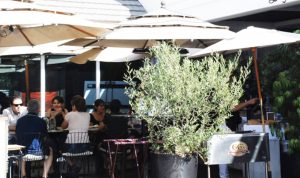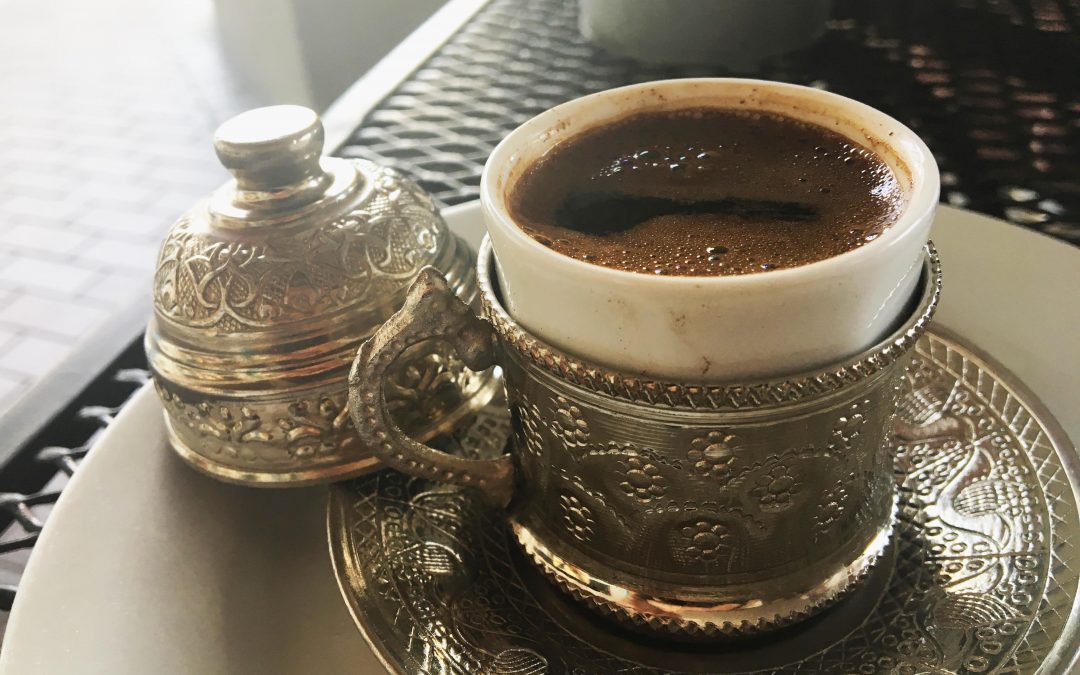For 14 years now, the two husband-and-wife teams of GG’s Bistro have managed to keep the life in the main level of this 540 South Coast Highway complex.
GG’s Bistro came about when two brothers, Bulent and Ragip Gundogar, decided it was time to get out of their successful fencing factory business in Turkey and do something else. In fact, not only were they ready to do something else, they were ready to move somewhere else, too.
In 2004, the brothers moved here with their wives (Hande with Bulent and Franziska with Ragip) to open a restaurant … a new enterprise for all four.

While GG’s has become a locals’ favorite for lunch, happy hour (M-F) and dinner, I love GG’s for Sunday morning breakfast. It’s the only day they serve breakfast, and it feels like a special treat every time I wake up on Sunday morning with the prospect of GG’s in my mind. For me, it feels that I’ve nestled myself into a streetside café in Europe.
History Behind Turkish Coffee …
This past Sunday, I joined my dear friend, Angelina Altishin, and a family friend, James, who was fresh in from Turkey and looking for a tech-related job. Quite by accident, I ordered the Turkish coffee, and I was in for an education from my Turkish friends!
It arrived in a tiny silver “shot glass” with an equally tiny lid. This little bugger, though, packs quite wallop.
It arrived with quite a history, too.
Turkish coffee was first brought to Istanbul in the 16th century by Syrian traders. Initially, it was reserved for royalty with elaborate ceremony by as many as 40 royal coffee makers per sitting.
How the Rest of Us Watered it Down
In short order, the brewing of Turkish coffee became a test of suitability for prospective brides as they were judged on the quality of their brew. As time went on, it turns out women got the last word in, brewing sweet coffee to indicate they were happy with the choice of their prospective groom, or brewing the bitter coffee “as is” to indicate unhappiness, thus the origination of the saying, “leaving a bitter taste in one’s mouth.”
The rich brew (one cup of water, two full teaspoons of coffee boiled until it perfectly foams) eventually found its way to Austria and France, where it’s said milk and cream was first added to dilute its strength (café latte or au lait).
In World War I, American soldiers were introduced to the bitter brew and, while they preferred it over their instant Folgers, they watered it down significantly, creating the first “Americano.”
A Fortune in the Coffee Grounds
When you’ve finished sipping Turkish coffee, you’re only halfway there. For centuries, many fortunes have been read from the muddy sediment left at the bottom of the cup.
Place the silver saucer atop the cup, swirl it three times clockwise at heart level, then place it on the table and carefully pick up the overturned cup. The sediment that streams onto the saucer is important as it represents a reading for your home and love life. The cup reading focuses on business, work, investments and any sort of evil eye coming to the surface.
Turkish cup fortune-telling always starts from the cup’s handle, moving from right to left if the person is right handed, and left to right if left handed. There are three types of reading (5-section, 4-section or 2-section), all dependent on how the reader has learned from his or her generations prior.
You can go online to find more than 30 of the most well-known Turkish coffee symbols or, wonder of all wonders, download the app while you sit (with a caffeine buzz) in this peaceful little patio of GG’s.

